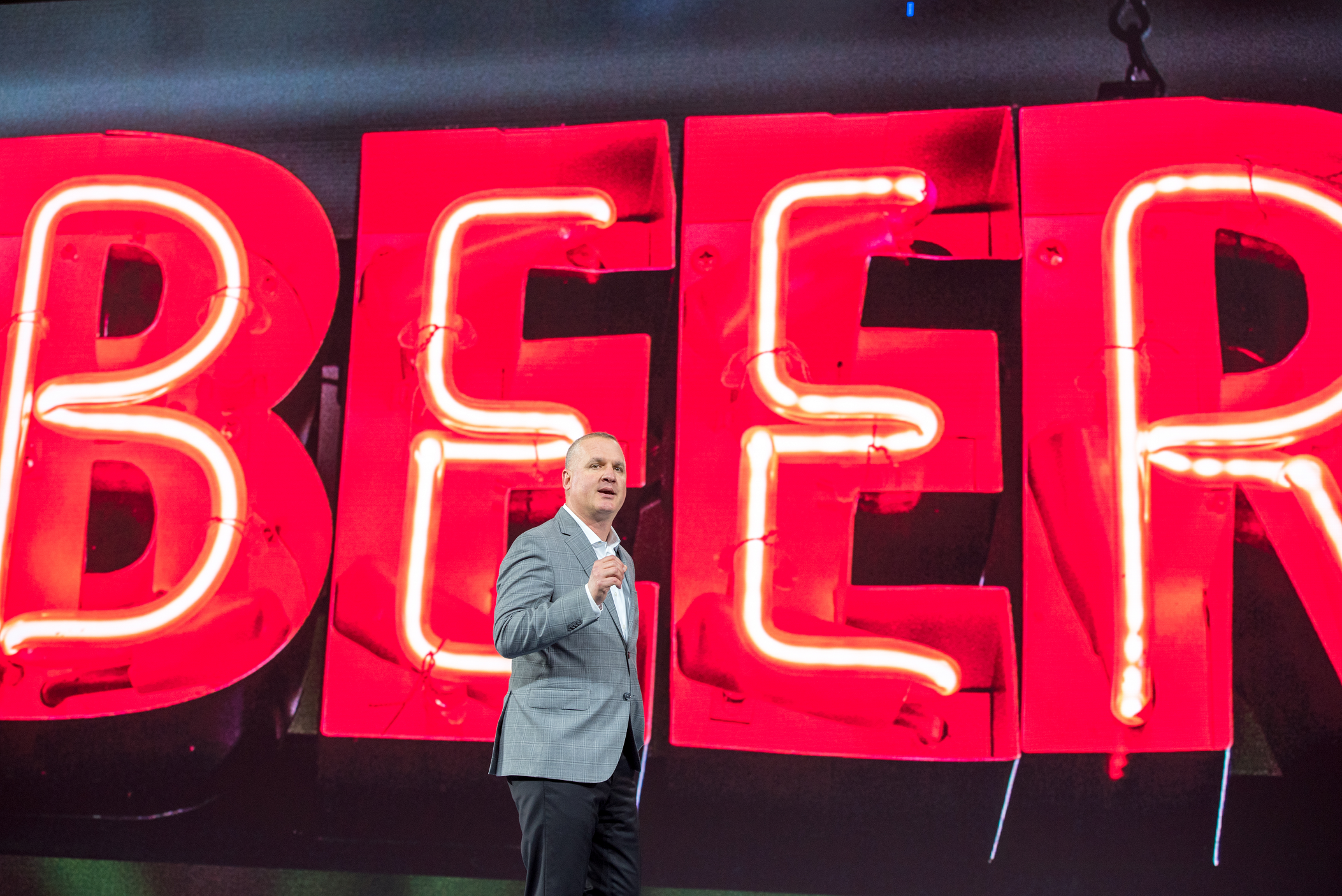It’s been a rough couple of years for the nation’s biggest brewers. Volumes are down. An explosion of craft breweries has fragmented the industry. Wine and spirits have gained market share, in part because they’ve done a better job of reaching a younger generation of legal-age drinkers, especially in bars and clubs.
Brewers are trying to figure out a way forward, but they’ve got divergent opinions on how to get there. The chasm was underscored Thursday at the Beer Marketer’s Insights Spring Conference in Chicago, where MillerCoors Chief Marketing Officer David Kroll and Constellation Brands Beer Division Chief Commercial Officer Bruce Jacobson presented their priorities for 2018 and beyond.
Jacobson, perhaps emboldened by Corona-maker Constellation’s extended run of success that runs counter to much of the industry, advocated an approach for retailers that dedicates more shelf and cooler space for so-called “high-end beers,” which Constellation defines as brews that sell for more than $25 a case.
By Constellation’s calculations, the company is the No. 1 U.S. supplier of these beers with a 26.2 percent share of sales dollars. It’s the fastest-growing segment in beer, and, he projected, one that will account for all of the industry’s growth over the next three years.
“There’s a lot of lost opportunity in the beer space today,” Jacobson said. “We need to align (shelf) space with high-end growth” because the overall beer business “is changing and moving high-end very quickly.”
Where should that shelf space come from? Jacobson estimated that 1 in 5 stock-keeping units, or SKUs, “could come off the shelf and the consumer wouldn’t care.” About 50 percent of those slower-selling SKUs come from craft, and do little more than confuse consumers and clutter beer shelves, according to Constellation’s research. Jacobson also advocated trimming back flavored malt beverages, premium light lagers and economy beers, arguing redundancies in price point and pack size.
Retailers, he said, should consider cutting their assortment of economy beers to two to three brands from five or six in order to “free up shelf space for something that consumers want.”
Turns out, however, that a lot of consumers drink economy beer. And when they’re shopping it, they want their brand. Retailers that axe economy brands or premium lights in favor of more “high-end beer” run the risk of alienating an entire class of drinkers.
“How does the beer industry get back to growth? It’s not just about the high end,” Kroll retorted in a question-and-answer session following Jacobson’s speech. “Our industry can only get to growth if each price tier is healthy. The math just doesn’t work. Sorry, Bruce, it just doesn’t. You can’t get the entire industry growing just through high end. Imagine if the car industry only sold BMWs. You’d have a lot less people driving cars. The No. 1 car selling in America today is still the Honda Accord.”
While Kroll agreed the above-premium segment is having a moment — including successful MillerCoors launches such as Arnold Palmer Spiked Half & Half, Crispin Rosé and Sol — he vehemently disagreed that the path to growth goes solely through “high-end” beers. “Recruiting new drinkers doesn’t happen very well through the high end,” Kroll said.
Innovation drives interest in the category, sampling of new products and growth, but “we can’t get the industry back to growth until we get the premium lights back to health and the economy segment back to health because it’s still a third of the industry.”
Economy beers, Kroll said, serve as an important entry point for drinkers into the beer segment, where some will later trade up into higher-priced products. Kroll referenced the MillerCoors plan to stabilize its economy portfolio, which resulted in four of its beers appearing on the Nielsen Top 10 Growth Brands list over the last year: Hamm’s, Miller High Life, Keystone Ice and Keystone Light. The latter “is bigger than all but one” of the 6,400 craft beer brands – Sam Adams-maker Boston Beer Co. – which, if stripped of hard sparkling water and hard tea, would be smaller than Keystone Light, Kroll said.
On top of that, the economy drinker is incredibly loyal. More than three quarters of economy consumers have a single brand or a small set or brands in mind when they walk into a retailer seeking to make a beer purchase, according to MillerCoors research.
If that segment isn’t healthy “you’re not doing a very good job recruiting drinkers into the category for the long-term health of the category,” Kroll said.
It takes an “all-of-the-above” approach to get the category back to growth, Kroll said. That includes strengthening American light lagers, like Coors Light, Bud Light and Miller Lite, which account for one in three beers sold in America and are among the fastest-moving brands on retailers’ shelves.
Consistency in messaging is key, he said, referencing the resurgence of Miller Lite since its advertising pivoted about three years ago to a story rooted in heritage and taste with fewer carbohydrates and calories than its primary competitor, Bud Light. As a result, it has picked up share in the segment and held share in the beer industry, he said.
Kroll expressed confidence that there are more good news stories on the horizon.
“Beer has been around for 1,000 years,” he said. “It ebbs and flows … and I think as we get into the end of the year, the storylines will change dramatically.”

